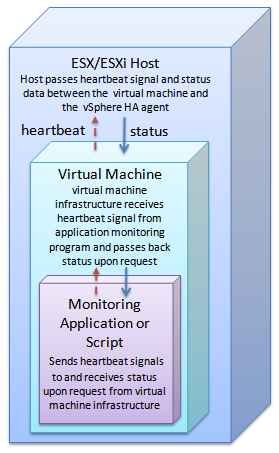The vSphere High Availability (HA) feature for ESXi hosts in a cluster provides protection for a guest OS and its applications, by restarting the virtual machine if a guest OS or application failure occurs. The HA feature provides this reset capability through two different mechanisms:
|
1
|
VM Monitoring – Guest OS heartbeats issued by the VMware Tools process.
|
|
2
|
Application Monitoring – Heartbeats issued by a program that uses the HA Application Monitoring SDK to communicate with the VMware Tools process and the vSphere HA agent. This mechanism involves local monitoring by the program to avoid the overhead of sending messages to and from vCenter Server.
|
Heartbeat and Status Signals depicts the monitoring and reset capability of host and virtual machine.
Additionally in vSphere 5.5 and later, the in-guest agent can set state to indicate it needs an immediate reset. This can be done without enabling heartbeats. The HA Application monitoring facility can reset the guest OS when ready to do so, if the in-guest agent has not changed state to say reset is no longer needed.
Using the HA Application Monitoring SDK, developers can write HA application monitoring programs in the C or C++ language. The HA Application Monitoring API is available with C language bindings only.
The application monitoring program sends an enable request to start the monitoring, possibly followed by a heartbeat signal. The vSphere infrastructure passes the signal up from your HA application monitoring program to the virtual machine, and then to the ESXi host. The HA application monitoring facility will reset the virtual machine if the application monitoring program stops sending a heartbeat signal, or requests a reset.
For more information about vSphere HA and application monitoring, see the vSphere Availability guide in the vSphere Documentation Center.
